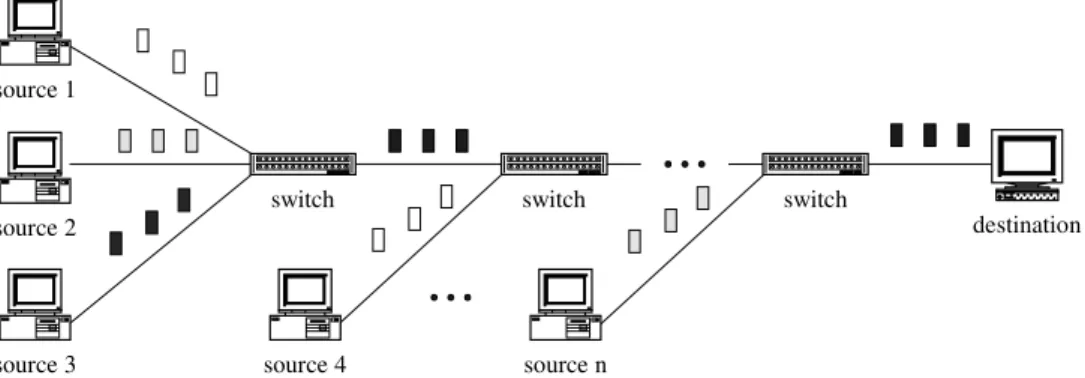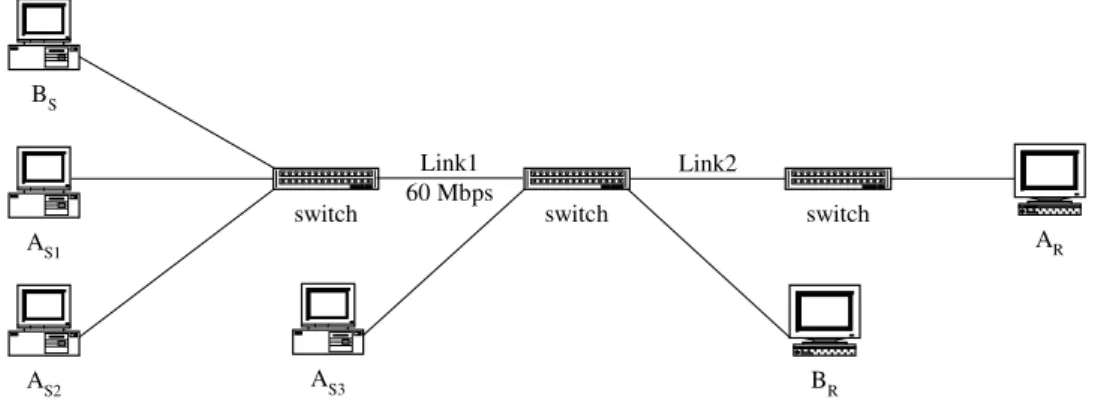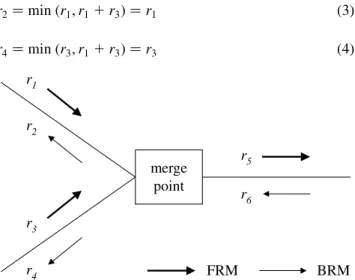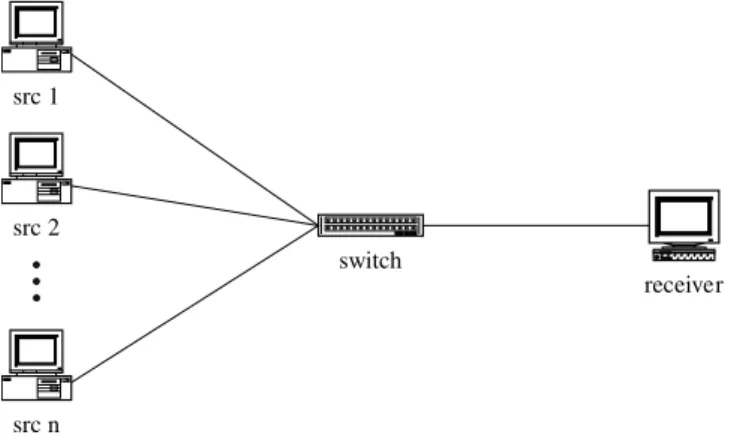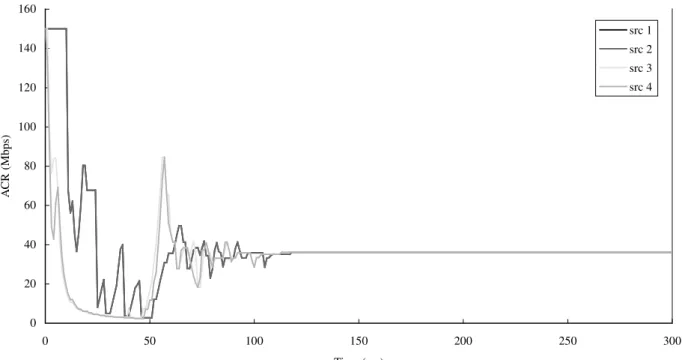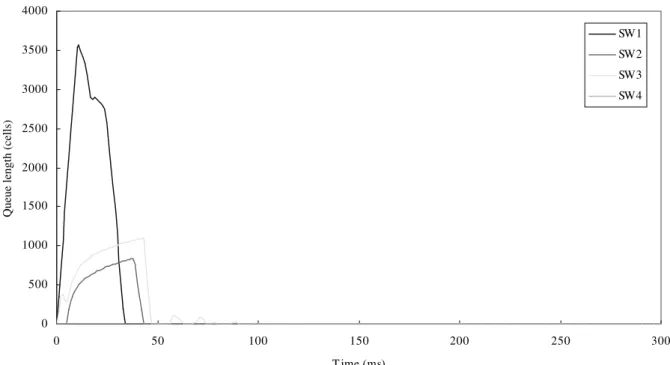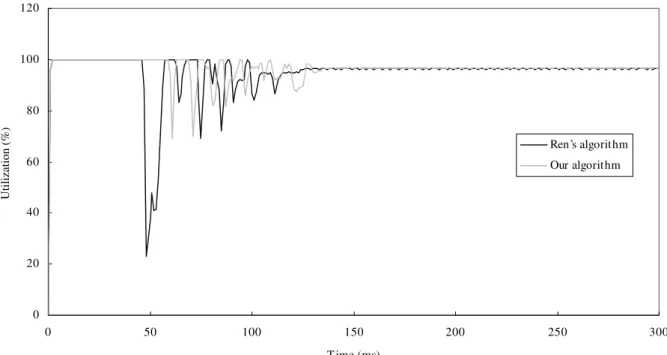Design and analysis of a merging algorithm for multipoint-to-point ABR
service in ATM networks
Chun-Liang Lee*,Yaw-Chung Chen
Department of Computer Science and Information Engineering, National Chiao Tung University, Hsinchu 30050, Taiwan, ROC Received 8 August 2000; revised 21 December 2000; accepted 22 December 2000
Abstract
In this paper,we propose a merging algorithm,which can provide ef®cient support for multipoint-to-point ABR service in ATM networks. By forwarding the FRM cells belonging to the VC with the largest FRM-cell arrival rate in a merge point,the proposed algorithm can achieve better link utilization than existing merging algorithms. In addition,the proposed algorithm reduces the number of FRM cells forwarded by a merge point. As a result,it can reduce the control overhead of ABR service. Most importantly,it does not incur extra complexity in switches. We also discuss the impact of different network topologies on our algorithm. Simulation results show that the proposed algorithm is able to achieve better performance while requiring signi®cantly fewer RM cells. q 2001 Elsevier Science B.V. All rights reserved.
Keywords: Asynchronous transfer mode; Available bit rate; Multipoint-to-point; Merging algorithm
1. Introduction
Multipoint communication is the exchange of informa-tion among multiple senders and multiple receivers. The support of multipoint communication in asynchronous transfer mode (ATM) networks is essential for applications such as audio/video conferences,distributed interactive simulations and replicated database synchronization. In recent years,issues regarding how to ef®ciently support multipoint-to-multipoint (mp±mp) available bit rate (ABR) service [3] have been studied extensively. A straight-forward way to provide this service is combining the point-to-multipoint (p±mp) and the multipoint-to-point (mp±p) ABR services [21]. While many studies have been done on p±mp ABR service [9,12,13,15,17,19], little literature is available on mp±p ABR service.
A switch algorithm,which supports mp±p ABR service can be functionally divided into two parts: rate allocation algorithm and merging algorithm. The function of the former is to calculate a proper cell rate for a connection to utilize the network ef®ciently and fairly. Several existing rate allocation algorithms for mp±p ABR services [7,16,20] have been developed by modifying point-to-point (p±p) rate allocation algorithms. In mp±p ABR service,cells from different sources are merged into the
same virtual connection (VC) in some merge points. Therefore,as the resource management (RM) cells belonging to different VCs leave a merge point,they are indistinguishable to the merge point when they return. A merge algorithm has the responsibility to send backward RM (BRM) cells to appropriate upstream branches when a BRM cell is received. Furthermore,it has to maintain the ratio of the number of FRM cells sent by a source to the number of received BRM cells equal to one.
In most existing merging algorithms [7,20,21], a merge point forwards all the arriving FRM cells to the outgoing link. Since these FRM cells originated from different sources,the current cell rates (CCR),which indicate the sending rates of the sources,in the FRM cells may be different. As mentioned before,these FRM cells are indistinguishable when they leave the merging point, and the downstream switches will use the CCRs to calculate the proper cell rate for this VC. If a small CCR is used,the calculated result will be a small value. This will cause unne-cessary rate reductions and link under-utilization. Further-more,it is not essential to forward all arriving FRM cells and this will be explained in Section 4.
In this paper,we propose a merging algorithm,which is able to lessen the unnecessary rate reductions. As a result,it can achieve higher link utilization than existing algorithms. The proposed algorithm also enhances the function of a merging algorithm that has not been addressed in the litera-ture. In existing studies,the action of merging refers to the
www.elsevier.com/locate/comcom
0140-3664/01/$ - see front matter q 2001 Elsevier Science B.V. All rights reserved. PII: S0140-3664(01)00300-0
* Corresponding author. Tel.: 1886-3-5731851; fax: 1886-3-5727842. E-mail address: leecl@csie.nctu.edu.tw (C.-L. Lee).
ATM layer behavior that maps multiple VCs into a single VC. The proposed algorithm,however,really ªmergesº the FRM cells belonging to different VCs. In other words,fewer FRM cells are forwarded to the outgoing link. Although in our algorithm some FRM cells are merged,we still keep the basic function of a merging algorithm. That is,the ratio of the number of FRM cells sent by a source to the number of received BRM cells is equal to one. This guarantees that our algorithm does not cause the source to receive less network status carried by BRM cells. Another advantage of the proposed algorithm is that more data cells can be sent into the network because the overhead of control cells (i.e. FRM cells) is reduced.
The rest of this paper is organized as follows. In Section 2,we discuss the related issues for mp±p ABR service. Section 3 reviews two existing merging algorithms. In Section 4,we ®rst state the motivation of this work and then describe the proposed merging algorithm. Section 5 addresses the numerical analysis of our algorithm. The analysis focuses on how much control overhead can be reduced for different network topologies. Simulation results are presented in Section 6 to evaluate the performance of the proposed algorithm. Finally,Section 7 concludes the paper and addresses the future research directions.
2. Related issues
2.1. The cell interleaving problem
In ATM networks,a switch uses the virtual path identi®er (VPI) and the virtual channel identi®er (VCI) carried in a cell header to forward the cell. A source sends cells with the assigned VCI and VPI,which are obtained when the connection was established,to its adjacent switch. When the switch receives a cell,it uses the VPI/VCI to lookup which output port the cell should be forwarded to,and modi®es the VPI/VCI. Eventually,the cell will arrive the destination via one or more switches. The destination reassembles the arriving cells to packets based on the VPI/VCI and the end-of-packet (EOP) bit carried in each cell.
An mp±p connection can be implemented as a shared
tree,as shown in Fig. 1. In such con®guration,the merge point maps ATM cells from different VCs into a single VC and eventually all data streams from multiple sources are merged into a single VC. In other words,cells from different sources will arrive the destination with the same VPI and VCI.
ATM adaptation layer 5 (AAL5) is commonly used by a variety of data applications because of its simplicity and higher ef®ciency. However,it does not provide multiplexing identi®cation in cells as AAL 3/4 does. If the cells belonging to different packets are interleaved,the destination cannot reassemble these packets. Therefore,it will drop these pack-ets. This is known as the cell interleaving problem. To solve this problem,several possible solutions were proposed in [8]. In this paper,we focus on the VC merging approach since it is more scalable than the other solutions. VC merging requires merge points to guarantee the integrity of packets. When a merge point receives an incoming cell of a given packets,it needs to store the cell in a separate buffer until the last cell arrives. The last cell is identi®ed by the end-of-packet (EOP) bit in the cell header. When the last cell is received,the merge point has to send all cells in the packet in an atomic manner. Intuitively,VC merging requires a switch to provide larger memory space for keep-ing the integrity of a packet. Widjaja proposed a realistic architecture for VC merging and indicated that it does not incur considerable overhead and memory requirement but can achieve higher throughput [23].
2.2. The fairness problem
For p±p connections,max±min fairness [10] is the most commonly used fairness de®nition. However,when mp±p connections are involved,the fairness de®nition becomes more complicated. Four types of fairness for mp±p ABR service have been de®ned: source-based fairness,VC/ source-based fairness,¯ow-based fairness and VC/¯ow-based fairness. The details of these fairness de®nitions can be found in [8]. In this paper,we focus on the source-based fairness,which only considers the active sources. In other words,the group membership is ignored while dealing with the fairness. Therefore,an mp±p connection with n sources can be considered as n p±p connections. How to achieve a
switch switch switch
source 1
source 2
source 3 source 4 source n
destination
speci®c de®nition of fairness depends on the rate allocation algorithm used in switches,and this is beyond the scope of this paper.
For example,Fig. 2 shows an mp±p connection and a p±p connection. Sources AS1, AS2 and AS3 are sending data to
destination AR,and source BSis sending data to destination
BR. The capacity of each link is 150 Mbps except Link1,
which has a capacity of 60 Mbps. To ®nd the fair rate allo-cation for each source,we can consider the mp±p connec-tion as three p±p connecconnec-tions. Therefore,the capacity of the bottleneck link,Link1,is equally distributed to AS1, AS2and
BS. The data rate available for AS3is 110 Mbps (i.e.
150-20-20),which is the capacity of Link2 minus the data rates allocated for both AS1and AS2.
2.3. Rate allocation algorithm
As mentioned in Section 1,a switch algorithm which supports mp±p ABR service comprises two parts,namely rate allocation algorithm and merging algorithm. Since this paper focuses on the merging algorithm,it is neces-sary to choose a rate allocation algorithm to cooperate with our merging algorithm. Many point-to-point rate allocation algorithms have been proposed for ABR service [4±6,14]. However, not all of them can be used in mp±p ABR service. Based on the following reasons, we choose the explicit rate indication for congestion avoidance (ERICA) switch algorithm [14] as the rate allocation algorithm used in this paper. First,ERICA is a well-known switch algorithm which is able to provide ef®cient rate allocation and achieve max±min fairness. Second,ERICA has been studied and modi®ed in many studies [1,2,22], and thus it is a more robust and well-tested algorithm. Third,it was extended in [7] to support mp±p ABR connections.
In the rest of this section,we brie¯y describe the ERICA algorithm for mp±p ABR service. For a complete descrip-tion of this algorithm,the reader can refer to [7,11]. ERICA requires a switch to measure the load factor of each link every ®xed time interval,called switch measurement inter-val. The load factor (z) is derived through the following
equation:
z ABR capacityInput rate :
The input rate is the incoming ABR traf®c measured in a measurement interval,and the capacity for ABR service is the remaining link capacity after serving those higher prior-ity service classes,such as CBR and VBR traf®c. For connection i,the switch uses a variable CCRito record the
maximum CCR in the arriving FRM cells in the current measurement interval. Once an FRM cell of connection i is received,the switch checks the CCR ®eld in the FRM cell and modi®es CCRiif necessary. That is,
CCRi max CCRi; CCR in the FRM cell:
Once a BRM cell of connection i is received,the switch ®rst checks to see if the output link is congested. If the load factor is larger than 1 1d,whered is a small fraction,the link is considered congested,and then the explicit rate (ER) ®eld of the BRM cell will be set to CCRi/z. This will cause
the connections passing through the switch to reduce their sending rates,and keep the load factor equal to 1. To calcu-late the ER when the link is not congested,we have to de®ne a variable maxERpre_intval,which is the maximum ER ever
calculated in the previous measurement interval. The switch then chooses the larger one of CCRi/z and maxERpre_intvalas
the ER. This can guarantee the fairness among the connec-tions passing through the switch. Once the ER is calculated, the switch will modify the ER ®eld in the BRM cell if the calculated result is smaller. Otherwise,the ER ®eld is kept the same. The following pseudo code summarizes the procedure mentioned above.
if z . 1 1d then ER CCRi=z; else
ER max CCRi=z; maxERpre_intval; end if
ER in BRM cell min(ER,ER in BRM cell);
To smooth out the variations of the variable maxER pre_int-val,the switch uses the exponential averaging to calculate
Link2
switch switch switch
Link1 60 Mbps BR BS AS2 AS1 AS3 AR
maxERpre_intval. At the end of every measurement interval,
maxERpre_intvalis calculated using the following equation:
maxERpre_intval 1 2a £ maxERcur_intval 1a£ maxERpre_intval:
The variable maxERcur_intval is the maximum ER ever
calculated in the current measurement interval,and the vari-able a is a parameter,which determines the weight of the previous result.
3. Previous works
In this section,we review two existing merging algo-rithms. The ®rst algorithm was proposed by Ren et al. in Ref. [20]. In their algorithm,once a merge point receives an FRM cell from an upstream branch,it will execute the rate allocation algorithm and return a BRM cell to the upstream branch immediately. In addition,it will forward the FRM cell to the outgoing link. When the merge point receives a BRM cell,it will retrieve the required information such as ER,CI and NI,and then discard this cell. The pseudo code of the merging algorithm is as follows:
Upon the receipt of an FRM cell from branch i:
Execute the rate allocation algorithm with this RM cell;
Return a BRM cell to branch i;
Forward this RM cell to the outgoing link; Upon the receipt of a BRM cell:
Execute the rate allocation algorithm with this RM cell;
Discard this RM cell;
Obviously,the above algorithm guarantees that the number of FRM cells sent by a source equals to the number of BRM cells received by the source. In addition,the algo-rithm is simple and does not require a switch to keep any information for an mp±p connection. However,it has two major problems. First,a merge point has to generate a BRM cell once it receives an FRM cell. This will introduce extra complexity in switches. Second,a merge point that receives the network status carried by BRM cells will not send a BRM cell to the upstream unless it receives an FRM cell. Thus,the delay of the network status is sensitive to the number of merge points along the path. To overcome these problems,another algorithm was proposed by the same authors in Ref. [21],in which a merge point does not have to generate a BRM cell upon receiving an FRM cell. Instead,the merge point sends BRM cells to appropri-ate upstream branches once it receives a BRM cell. As a result,a Ready ¯ag,which is associated with each upstream branch for an mp±p connection,is needed to control the number of BRM cells returned to the source. Whenever a
merge point receives an FRM cell from a branch,it sets the corresponding Ready ¯ag to 1. Once it receives a BRM cell, it sends the BRM cell to the branches whose corresponding ¯ag equal to 1 and then resets the ¯ag. The pseudo code of the merging algorithm is as follows:
Upon the receipt of an FRM cell from branch i:
Execute the rate allocation algorithm with this RM cell;
Readyi 1;
Forward this RM cell to the outgoing link; Upon the receipt of a BRM cell:
Execute the rate allocation algorithm with this RM cell;
for each upstream branch i do if Readyi 1 then
Send a BRM cell to branch i; Readyi 0;
end if end for
As compared to the ®rst algorithm,this algorithm has the following advantages:
1. Lower complexity: as we can see in the above pseudo code,the action for sending BRM cells to the upstream links is triggered by the arrival of a BRM cell from the downstream link. Therefore,it incurs lower complexity in switches;
2. Shorter delay of network status: the network status carried in the arriving BRM cells is directly sent to the upstream branches if allowed (i.e. Ready ¯ag equals to 1). As a result,this algorithm does not have the problem of network status delay as described in the ®rst algorithm. Due to the above advantages,this algorithm is more preferable as a merging algorithm because it is simpler and less sensitive to the number of the merge points along a path. In fact,it has also been used in other papers to study the issues regarding the mp±p ABR service [7,8]. In the rest of the paper,we only consider this algorithm and denote it as Ren's algorithm.
4. Proposed merging algorithm 4.1. Motivation
Although Ren's algorithm is better than the ®rst algo-rithm we mentioned,it has the following two drawbacks. First,it forwards all the arriving FRM cells to the down-stream network. These FRM cells from different VCs are indistinguishable to the downstream switches when they leave the merge point. Most rate allocation algorithms, including ERICA,use the CCR ®eld in FRM cells to calcu-late the allowed cell rate for the VC. Since the CCRs of
different VCs are different,if a small CCR is used to calcu-late the allowed cell rate by the downstream switches,this may cause unnecessary rate reductions.
Second,since the FRM cells are indistinguishable when they leave the merge point,it is unnecessary for a merge point to forward all the arriving FRM cells. In ATM networks,RM cells are used to convey the network status to sources for the closed-loop ¯ow control. This means RM cells do not carry users data. In other words,they are control overhead,which should be kept as few as possible. However,reducing the amount of RM cells does not always bene®t the throughput since it also reduces the frequency of network status received by a source. As a result,the source may response to the change of network status slowly,which leads to worse throughput. In the rest of this section,we will show that it is possible to forward less FRM cells but can still generate enough BRM cells sent to the source. More importantly,it can achieve better ef®ciency.
Consider the scenario shown in Fig. 3. Two VCs are merged into one VC in a merge point. The variables r1
and r3 represent the FRM cell rates of these two VCs
while variable r2and r4represent the BRM cell rates
gener-ated by the merge point for these two VCs. The variable r6
denotes the rate of the BRM cells from the downstream switch.
As in Ren's algorithm there is only one bit used for each branch to record the status of the arriving FRM cells,we have the following equations:
r2 min r1; r6 1
r4 min r3; r6 2
Recall that in Ren's algorithm,a merge point forwards every FRM cell to the outgoing link. Hence,we have r5 r11 r3: Suppose that the transmission rates of sources do not vary dramatically. The values of r5 and r6will be very close (i.e. r5 ù r6). Therefore,Eqs. (1) and (2) can be rewritten as
r2 min r1; r11 r3 r1 3
r4 min r3; r11 r3 r3 4
As shown in Eqs. (3) and (4),for each branch,the merge point keeps the ratio of the number of FRM cells to that of the BRM cells close to 1,and this is one of the required functions of a merge point.
Our initial idea is that if the merge point forwards the FRM cells of the VC with the rate of max(r1, r3),we have
r6ù r5 max r1; r3 5
Substituting Eq. (5) into Eqs. (1) and (2),we have the following equations:
r2 min r1; max r1; r3 r1 6
r4 min r3; max r1; r3 r3 7
Therefore,the merge point can forward fewer FRM cells but can still generate enough BRM cells for all branches. For a switch,which merges more than two VCs,we can forward the FRM cells of the VC with the largest cell rate to achieve the same purpose.
4.2. Proposed algorithm
Since it is complex and hard to determine the cell rate of each VC,we try to replace the ¯ag with a counter,denoted as cntr,for each branch to achieve the same purpose. In the following,we present our proposed algorithm. When a merge point receives an FRM cell from an upstream branch, it increases the corresponding counter by 1. If the counter value is the largest among all counters after the increment, the merge point will send the FRM cell to the outgoing link. Otherwise,it will discard the FRM cell. When the merge point receives a BRM cell,it sends the BRM cell to the upstream braches whose corresponding counters are larger than 0. Before sending a BRM cell,the merge point will execute the rate allocation algorithm to calculate the explicit rate for the VC and put the rate in the BRM cell. The pseudo code of the proposed algorithm is as follows:
Upon the receipt of an FRM cell from branch i:
Execute the rate allocation algorithm with this RM cell;
cntri11:
if (cntriis the largest among all branches) then
Forward this RM cell to the outgoing link; else
Discard this RM cells; end if
Upon the receipt of a BRM cell: for each upstream branch i do
if (cntri. 0) then
Execute the rate allocation algorithm; Send a BRM cell to branch i; cntri2 2 ; end if end for merge point r1 r2 r3 r4 r5 r6 FRM BRM
As compared with the existing algorithms,our algorithm incurs subtle extra complexity both in space and time. First, the memory size required by each branch is the size of a counter,which is determined by the maximum distance from a merge point to the destination and the maximum cell rate of a VC. Practically,one or two bytes should be enough. With the price of memory getting cheaper and cheaper,the cost of counters can be ignored. If the counter size is too small but the transmission path is too long,the counter may over¯ow and cause our algorithm to mis-behave. The problem,however,can be overcome easily by implementing a non-over¯ow addition operation.
Second,in our algorithm,a merge point has to determine whether the value of a counter is the largest among all the branches. The time complexity of ®nding the largest one in a set of values is O(n),where n denotes the number of branches. Obviously, n is no larger than the number of ports in a switch,and it is usually a small value. Therefore, our algorithm does not incur considerable complexity. 4.3. Complexity reduction
As discussed in Section 4.2,the proposed algorithm is simple and cost effective. However,in order to make the proposed algorithm more practical,we present an improved approach whose time complexity is only O(1). We introduce a variable MAX for each mp±p connection. The variable MAX is used to keep the largest counter value and it is initially set to 0. Once a merge point receives an FRM cell from a branch,it will check whether the value of the corresponding counter is equal to MAX before increasing the counter. If these two values are identical,that means the counter value will become the largest one after the increment. Therefore,this FRM cell will be forwarded to the outgoing link and both the counter and MAX are increased by 1. When the merge point receives a BRM cell,it will perform the same operation as our ®rst algo-rithm. In addition, MAX is decreased by 1. The improved algorithm is shown as follows:
Upon the receipt of an FRM cell from branch i:
Execute the rate allocation algorithm with this RM cells;
if cntri MAX then cntri11;
MAX11;
Forward this RM cell to the outgoing link; else
Discard this RM cell; end if
Upon the receipt of a BRM cell: MAX 2 2 ;
for each upstream branch i do if (cntri. 0)
Execute the rate allocation algorithm;
Send a BRM cell to branch i; cntri2 2 ;
end if end for
5. Numerical analysis
In this section,we analyze the quantity of RM cells that can be reduced by our proposed algorithm. First,the analy-sis is based on a single merge point. Then we can use the analysis result to calculate the total number of reduced RM cells for an mp±p connection. We also discuss the perfor-mance of our algorithm under different network topologies. Especially,we are interested in the network topologies in which our algorithm will have either the best or the worst performance. Since it is hard to analyze the proposed algorithm during the bandwidth contention period,in the following discussion we assume the system is in steady state.
Given an mp±p connection with n sources,as stated in Section 1,the data streams from these n sources will be merged in some merge points in the network. Let Ridenote
the percentage of FRM cells reduced by our algorithm in a merge point,which has i upstream sources. Assume that these sources are src1, src2,¼, srci. Let ri be the rate of
FRM cells sent from srci. Recall that Ren's algorithm
forwards all the received FRM cells to the downstream network. On the contrary,our proposed algorithm forwards the FRM cells belonging to the VC with the largest FRM-cell arrival rate. Therefore,we have the following equation: Ri Pi j1rj2 max r1; r2; ¼; ri Pi j1rj 1 2 max r1Pi; r2; ¼; ri j1rj : 8 If the merge point is the bottleneck and there is no constrained source,we have
r1 r2 ¼ ri: 9
Applying Eq. (9) to Eq. (8),we have the following equa-tion,which is the maximum percentage of FRM cells that can be reduced by our algorithm.
Ri 1 2 Pir1
j1r1
1 2 1i: 10
After deriving the percentage of FRM cells reduced,we can derive the amount of saved bandwidth of a link as follows. Let BWRM and BWABR denote the link capacity
used by RM cells and ABR traf®c,respectively. Then the amount of saved bandwidth (BWsaved) can be derived as
follows:
BWsaved BWRMRi: 11
In ABR service,the RM cells are sent by source after Nrm-1 data cells,where Nrm is a parameter with a default value of 32. In other words,the ratio of the number of RM cells to the number of data cells is 1/(Nrm-1). Therefore,we have the following equation:
BWRM BWNrmABR: 12
Substituting Eq. (12) into Eq. (11),we have
BWsaved BWABR
Nrm Ri: 13
So far we have analyzed the amount of saved bandwidth in a single merge point. The total amount of saved band-width in the network can be calculated by considering all the merge points. In the rest of this section,we discuss both the best case and the worst case of our proposed algorithm from the aspect of network topology. First of all,we consider the network topology in which our algorithm will have the best performance. Same as that speci®ed in the previous section, we assume that there is a mp±p connection with n sources. Since our algorithm merges VCs in a merge point,the best case would be that all VCs are merged in only one merge point. Therefore,the least amount of FRM cells will ¯ow in the network. Fig. 4 shows the network con®guration,in which the FRM cells in n 2 1 out of n VCs would be merged. Because there is only one merge point,the percen-tage of FRM cells reduced can be derived through Eq. (8)
where i n. The largest value of Riwill appear in the case
that all sources have the same transmission rate,and it can be derived through Eq. (10).
Contrary to the best case,the network topology of the worst case would be that n VCs are merged with the largest number of merge points,that is,n 2 1. Fig. 5 shows the network con®guration of the worst case. When r1 or r2is
the maximum rate among all source transmission rates,our algorithm reduces least amount of FRM cells. In other words,one of the following two equations holds in the worst case
r1 max ri 1 # i # n 14
r2 max ri 1 # i # n: 15
Without loss of generality,we assume that Eq. (14) holds in the worst case. The percentage of FRM cells (Rnetwork)
totally reduced can be derived as follows:
Rnetwork Pn i1 n 2 i 1 1ri2 r12 n 2 1r1 Pn i1 n 2 i 1 1ri2 r1 ;i $ 2: 16
In the worst-case con®guration,the upper bound of R net-workcan be obtained when Eq. (9) holds. This means that the
outgoing link of the last merge point is the bottleneck link, and it is fairly shared by n sources. If the fair rate share of each source is M,we can derive the upper bound of Rnetwork
switch src 1
src 2
src n
receiver
Fig. 4. Con®guration of the best case.
receiver src 1
switch 1 switch 2 switch n-1
src 3
src 2 src n
through the following equation: Rnetwork Pn i1 n 2 i 1 1M 2 M 2 n 2 1M Pn i1 n 2 i 1 1M 2 M n n 1 2 ;i $ 2: 17 6. Simulation results
To evaluate the performance of the proposed algorithm, we present the simulation results in this section. The simu-lation con®guration used is shown in Fig. 6,in which each link has a capacity of 150 Mbps. The length of each link connecting adjacent switches is shown in the ®gure. The other access links are assumed to be 100 m long. There is a mp±p connection,which has four sources,src1, src2, src3 and src4,sending data to the same destination. In our simulation,we assume that the sources always have data to transmit,and each cell stream is generated according to the allowed cell rate of the corresponding source. The simulation time is 300 ms,which is long enough for the simulation process to reach the steady state. The parameters of ABR source and ERICA are shown in Tables 1 and 2, respectively. The values of ERICA parameters are set according to the guidelines stated in Ref. [11].
In the rest of this section,we compare the performance of our proposed algorithm to Ren's algorithm in four aspects: the allowed cell rate (ACR) of each source,the queue occu-pancy of each switch,the number of FRM cells received by the destination,and the utilization of the bottleneck link.
Figs. 7 and 8 show the ACR of each source in Ren's and our algorithms,respectively. Since the ICR of each source is set to 150 Mbps (i.e. PCR),all switches will experience congestion in the beginning of the simulation. After the sources reduce their rates,they will start to contend for
the bandwidth of the bottleneck link. Therefore,Figs. 7 and 8 can demonstrate the basic behavior of Ren's and our algorithms. As shown in the ®gures,the time required for sources to reach the stable state is approximately 120 ms in Ren's algorithm,while it is slightly longer in our algo-rithm,which is about 130 ms. Although a little more time is required for our algorithm to reach the steady state,we can see that the ACR of each source in both algorithms are very close to the fair rate after time T 100 ms. This shows that our algorithm does not degrade the ef®ciency as contrast to Ren's algorithm,while using much less RM cells. In addi-tion,in Ren's algorithm,the ACRs of src1 and src2 decrease to very low values,say less than 5 Mbps,during several time periods from T 20 to 50 ms,while in our algorithm they are kept larger than 20 Mbps. This is because Ren's algorithm forwards all received FRM cells belonging to different sources to the downstream node. As we can see in Fig. 7,during the time period from T 20 to 50 ms,the ACRs of src3 and src4 are very small,and the information is indicated in the CCR ®elds of the FRM cells sent from src3 and src4. Once swtich3 uses the information to calculate the new explicit rate of the VC,it will get a wrong result,which causes src1 and src2 to reduce their sending rates unneces-sarily. On the contrary,the proposed algorithm does not have this problem. In our algorithm,a merge point forwards the FRM cells,which belong to the VC with largest FRM-cell arriving rate. In other words,only the FRM FRM-cells from the source with largest ACR will be forwarded by the merge point. Therefore,our algorithm can avoid the unnecessary rate reductions.
Figs. 9 and 10 show the queue length in each switch under different algorithms. As seen in the ®gures, switch1 has the largest queue length since src1 and src2 have the largest round-trip times. However, switch3 is the slowest one whose queue length is reduced to zero because it is the bottleneck node. Comparing these two ®gures,the time required to reduce the queue length to zero is slightly longer
receiver src 1
switch 1 switch 2 switch 3
1000 km 100 km
src 3
src 2 src 4
switch 4 10 km
Fig. 6. Simulation con®guration.
Table 1
Source parameters
Parameter Value Meaning
MCR 1 Mbps Minimum cell rate
PCR 150 Mbps Peak cell rate
ICR 150 Mbps Initial cell rate
RIF 0.0625 Rate increase factor
Table 2 Switch parameters Parameter Value a 0.1 d 0.1 Target utilization 0.9
for our algorithm than that for Ren's algorithm. The main reason is that Ren's algorithm causes unnecessary rate reductions; therefore,more bandwidth is used to drain the queue. This does not mean that our algorithm fails to control the queue length ef®ciently. In fact,our algorithm provides higher link utilization than Ren's algorithm. This will be discussed later.
Fig. 11 shows the number of received FRM cells in the destination for Ren's and our algorithms. The results are expressed as a percentage of the number of received FRM
cells in Ren's algorithm so we can see that the results for Ren's algorithms are all 100%. As stated in our simulation con®guration,the link between switch3 and swtich4 is the bottleneck link,where all data streams pass through. There-fore,the link capacity is fairly allocated to these four sources. By Eq. (10) where i equals to 4,the percentage of FRM cells reduced by our algorithm is 75% as compared to Ren's algorithm. As seen in Fig. 9,when the bandwidth contention period (i.e. from time T 0 to 60 ms) is over,the number of received FRM cells in our algorithm is kept at
0 20 40 60 80 100 120 140 160 0 50 100 150 200 250 300 Time (ms) A C R (Mbps) src 1 src 2 src 3 src 4
Fig. 7. ACRs in Ren's algorithm.
0 20 40 60 80 100 120 140 160 0 50 100 150 200 250 300 Time (ms) A C R (Mbps) src 1 src 2 src 3 src 4
25% of that in Ren's algorithm,which is consistent with our analysis. Even in bandwidth contention period,our algo-rithm still reduces considerable amount of FRM cells except at time T 60 ms. This is because Ren's algorithm reduces the ACRs of src1 and src2 unnecessarily as discussed earlier,and the queue of swith3 is drained off before the ACRs increase. Therefore,during the time period from T 50 to 60 ms the number of cells passing through swith3 in Ren's algorithm is much less than that in our algorithm. In this case,the destination receives more FRM
cells in our algorithm than it does in Ren's algorithm. For further veri®cation,Fig. 12 illustrates the utilization of the bottleneck link. As we expected,the link utilization in Ren's algorithm degrades to approximately 20% around time T 50 ms,while it keeps at a higher value in our algorithm. 7. Conclusions and future work
In this paper,we have proposed a merging algorithm,
0 500 1000 1500 2000 2500 3000 3500 4000 0 50 100 150 200 250 300 T ime (ms) Queue length (cells) SW1 SW2 SW3 SW4
Fig. 9. Queue lengths in Ren's algorithm.
0 500 1000 1500 2000 2500 3000 3500 4000 0 50 100 150 200 250 300 T ime (ms) Queue length (cells) SW1 SW2 SW3 SW4
which has rarely been addressed in the literature. By forwarding the FRM cells belonging to the VC with the largest FRM-cell arrival rate,the proposed algorithms are able to decrease the unnecessary rate reductions. As a result, link utilization can be improved as compared to existing algorithms. To deal with the arrival of an FRM cell or a BRM cell,the running time of the proposed algorithm is O(1),which means that our algorithm does not incur extra complexity in the switch. In addition,the proposed algorithm can reduce the quantity of FRM cells sent to the
downstream network. We have also analyzed how much control overhead can be reduced under different network topologies.
As mentioned in Section 2.2,this paper focuses on the source-based fairness. Issues regarding other fairness de®nitions still need further study. As new fairness de®ni-tions have been proposed [18],how to design a good rate allocation algorithm and merging algorithm for different fairness de®nitions,even for all of them,is a challenging work. With the lessons learnt from this work,we are 0 20 40 60 80 100 120 0 50 100 150 200 250 300 T ime (ms) Percentage o f recei ve d FRM cells (%) Ren’s algorithm Our algorithm
Fig. 11. Number of received FRM cells.
0 20 40 60 80 100 120 0 50 100 150 200 250 300 T ime (ms) Utilization (%) Ren’s algorithm Our algorithm
currently working on designing a rate allocation algorithm, which cooperates with the proposed merging algorithm to support more than one types of fairness.
Acknowledgements
The authors would like to thank the anonymous reviewers who provided helpful feedback on the manuscript.
References
[1] Y. Afek,Y. Mansour,Z. Ostfeld,Phantom: a simple and effective ¯ow control scheme,Proc. ACM SIGCOMM (1996) 169±182. [2] A. Arulambalam,X. Chen,N. Ansari,Allocating fair rates for
avail-able bit rate service in ATM networks,IEEE Commun. Mag. 34 (11) (1996) 92±100.
[3] The ATM Forum Technical Committee. ATM Forum traf®c manage-ment speci®cation version 4.1,ATM Forum AF-TM-0121.000, March 1999.
[4] A. Charny,D.D. Clark,R. Jain,Congestion control with explicit rate indication,Proc. Int. Conf. Commun. 3 (6) (1995) 1954±1963. [5] Y.C. Chen,C.T. Chan,S.C. Hu,On the effective traf®c control of
ABR services in ATM networks,IEICE Trans. Commun. 2 (2) (1998) 417±430.
[6] F.M. Chiussi,A. Arulambalam,Y. Xia,X. Chen,Explicit rate ABR scheme using traf®c load as congestion indicator,Proc. 6th Int. Conf. Comp. Commun. Networks 9 (1997) 76±84.
[7] S. Fahmy,R. Jain,R. Goyal,B. Vandalore,A switch algorithm for ABR multipoint-to-point connections,ATM Forum Contribution 97-1085R1,December 1997.
[8] S. Fahmy,R. Jain,R. Goyal,B. Vandalore,Fairness for ABR multi-point-to-point connections,Proc. SPIE Symp. Voice Video Data Commun.,vol. 3530,Conference on Performance and Control of Network Systems II,(11) (1998) 131±142.
[9] S. Fahmy,R. Jain,R. Goyal,B. Vandalore,S. Kalyanaraman,S. Kota, P. Samudra,Feedback consolidation algorithms for ABR point-to-multipoint connections in ATM networks,Proc. IEEE INFOCOM 3 (1998) 1004±1013.
[10] J.M. Jaffe,Bottleneck ¯ow control,IEEE Trans. Commun. 29 (7) (1980) 954±962.
[11] R. Jain,S. Fahmy,S. Kalyanaraman,R. Goyal,ERICA switch algo-rithm: a complete description,ATM Forum 96-1172,August 1996. [12] T. Jiang,M. Ammar,E.W. Zegura,Inter-receiver fairness: a novel
performance measure for multicast ABR sessions,Proc. ACM SIGMETRICS 6 (1998) 202±211.
[13] T. Jiang,E.W. Zegura,M. Ammar,Improved consolidation algo-rithms for point-to-multipoint ABR service,Proc. IEEE ATM Work-shop (1998) 195±201.
[14] S. Kalyanaraman,R. Jain,S. Fahmy,R. Goyal,B. Vandalore,The ERICA switch algorithm for ABR traf®c management in ATM networks,IEEE/ACM Trans. Networking 8 (1/2) (2000) 87±98. [15] D.H. Kim,Y.B. Park,J.K. Kim,Point to multipoint ABR ¯ow control
in ATM networks,Proc. IEEE Conf. High Perform. Switching and Routing 6 (2000) 177±184.
[16] W.M. Moh,Y. Chen,Design and evaluation of multipoint-to-point multicast ¯ow control,Proc. SPIE Conf. Perform. Control Network Systems II 11 (1998) 143±154.
[17] W.M. Moh,Y. Chen,B. Niizawa,Branch-point algorithms for multi-casting ATM ABR protocols,Proc. IEEE Workshop ATM 5 (1998) 202±211.
[18] U.T. Nguyen,I. Katzela,A ¯exible multipoint-to-point traf®c control algorithm for ABR services in ATM networks,Proc. IEEE Conf. High Perform. Switching Routing (2000) 185±194.
[19] W. Ren,K.Y. Siu,H. Suzuki,On the performance of congestion control algorithms for multicast ABR service in ATM,Proc. IEEE ATM Workshop (1996).
[20] W. Ren,K.Y. Siu,H. Suzuki,Multipoint-to-point ABR service in ATM networks,Proc. Int. Conf. Commun. 3 (6) (1997) 1185±1190. [21] W. Ren,K.Y. Siu,H. Suzuki,M. Shinohara,Multipoint-to-multipoint ABR service in ATM,Computer Networks ISDN Systems 30 (10) (1998) 1793±1810.
[22] D. Tsang,W. Wong,A new rate-based switch algorithm for ABR traf®c to achieve max±min fairness with analytical approximation and delay adjustment,Proc. IEEE INFOCOM 3 (1996) 1174±1181. [23] I. Widjaja,A.I. Elwalid,Performance issues in VC-merge capable
switches for multiprotocol label switching,IEEE JSAC 17 (6) (1999) 1178±1189.
